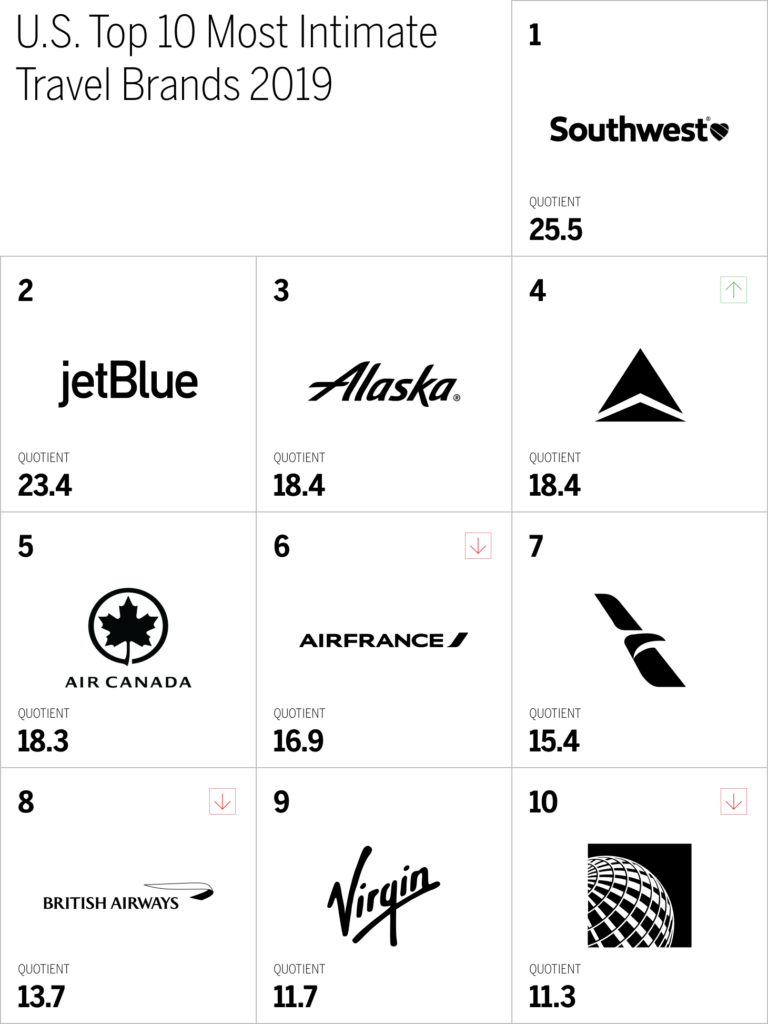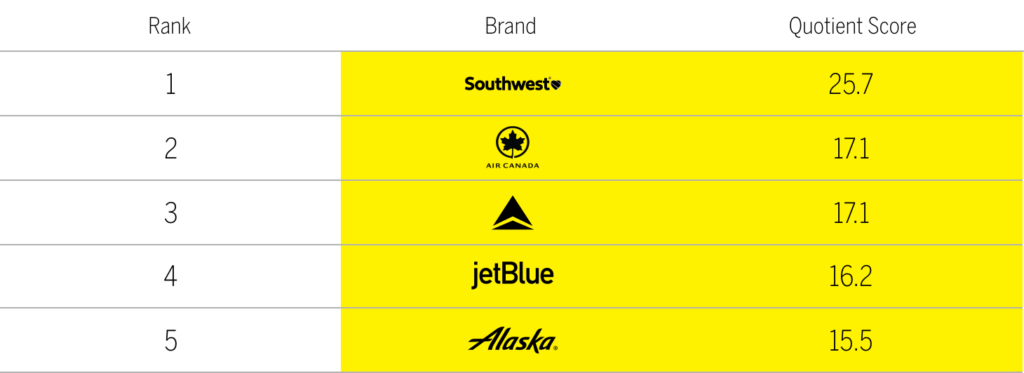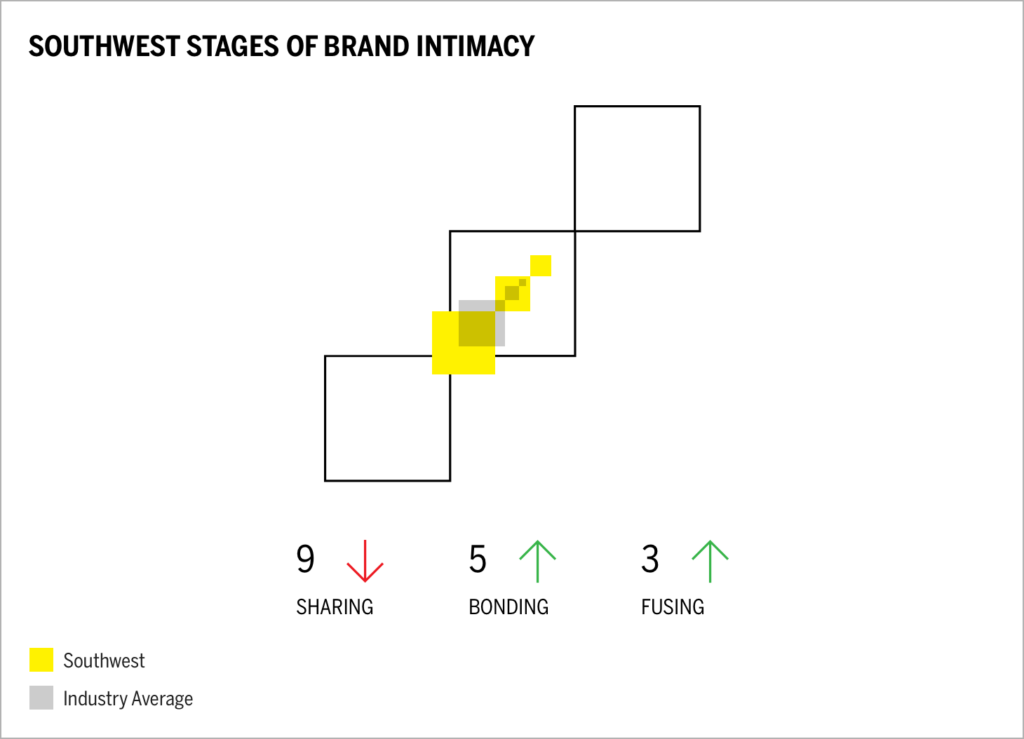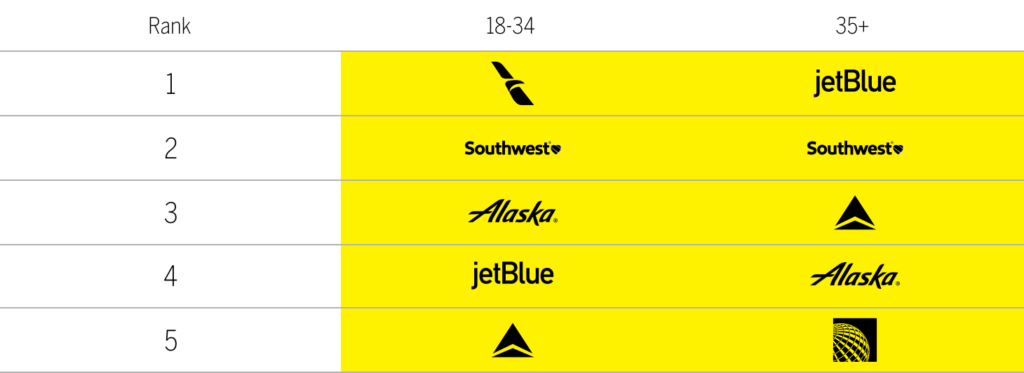Overview
- For the third year in a row, Southwest Airlines is the most intimate brand in the travel industry
- It is by far the most intimate travel brand for users earning less than $100,000 annually
- Southwest also leads the category for its percentage of users in the most intimate stages of Brand Intimacy: bonding and fusing
Recently, the travel industry has had difficulty connecting emotionally with consumers. For the the past three years, it has ranked last out of the fifteen industries in our annual Brand Intimacy Study.

Although the industry has been underperforming, one brand still stands out as the strongest intimate travel brand: Southwest Airlines. It has been the industry leader for the last three years. In a category that often lacks differentiation due to commoditization and consolidation, Southwest has been able to distinguish itself and cultivate Brand Intimacy, creating a significant advantage because consumers are more willing to engage with, use, and pay a premium for intimate brands. Whether it is the heart logo or the focus on customer service, Southwest’s brand is built on an emotional foundation that is uncommon among travel brands. To better understand the intimate relationships it has built with its users, we are detailing our key findings on Southwest Airlines.
Intimacy under $100K
One area in which Southwest is able to distinguish itself is in its ability to appeal to users with incomes under $100,000. This is significant because the travel industry as a whole has stronger emotional connections with those making $100,000 or more, with a Brand Intimacy Quotient of 25.6 compared to 13.7 for those earning less than $100,000.
Top travel brands for users with incomes under $100,000

When it comes to consumers earning less than $100,000, Southwest is the #1 brand by a significant margin (8.6 points). This clear leadership among users with incomes under $100,000 not only indicates that Southwest appeals to a broader range of incomes, but also shows that it is able to stand out from the rest of the category by connecting with an audience that is otherwise less intimate with brands in the industry.
After decades of growth, Southwest is no longer the discount airline it once was, but still this perception persists. It won’t always be the cheapest option for your trip, but if Southwest is among the cheapest options, it will often be the best deal because a standard ticket includes two checked bags for free, whereas other airlines charge a fee for any luggage other than a personal item. Although Southwest is no longer the cheapest airline, it continues to provide value at the low end of its offering.
Keeping customers close
The stages of Brand Intimacy identify the degree of intensity in a relationship between a consumer and a brand, increasing from sharing to bonding to fusing. In the travel industry, Southwest has the highest percentage of users in the most intense stages: bonding and fusing. This indicates that it is the most successful travel brand at building close relationships with its users.

In the bonding stage, the relationship between a person and a brand becomes more committed and trust is established between the two. Southwest’s relatively high percentage of users in this stage reflects how they trust and commit to the brand, which is likely due in part to Southwest’s commitment to being transparent with its prices (something Southwest calls “Transfarency®”) and to offering free baggage checking and flight changes. These commitments demonstrate to travelers that they can trust Southwest and that the airline is worthy of their business.
Southwest is also able to bond with its customers through one of its most unique assets: its employees. Southwest employees have a reputation for being happy and friendly and for offering great service. For the second year in a row, Southwest was the highest ranking low-cost carrier according to J.D. Power.¹ The outstanding performance and satisfaction of Southwest employees is a direct result of how their company treats them. The company has never had a layoff or cut pay and has had a profit-sharing program since 1974, which has paid out $544 million to employees (about 10.8 percent of each eligible employee’s compensation) this year.² Southwest recognizes that its employees are the human face of its brand; by treating them with appreciation and respect, the brand greatly improves its ability to bond emotionally with customers.
Fusing is the most intense stage of Brand Intimacy—it occurs when a person and a brand are inexorably linked and co-identified. Southwest leads for the percentage of users in this stage, meaning it has the largest proportion of users who feel strongly attached to the brand. This level of closeness between users and the brand may be a result of Southwest’s impressive loyalty and rewards programs. Its Rapid Rewards® program was named Program of the Year at this year’s Freddie Awards and the brand also won Best Loyalty Credit Card.³
Appealing across age groups
It makes sense for all travel brands to try to appeal broadly to different age groups. However, creating an airline brand that targets, for example, millennials seems like a risk this industry would hesitate to take, but no brand is as successful at this as Southwest.
Top five travel brands by age

Although Southwest is not the #1 brand for either age group, its position at #2 for users 18–34 and for those 35 and older highlights its ability to connect across a range of ages. American Airlines is the leading brand among millennials but does not rank in the top five for older users, and Jetblue leads among users 35 and older but is #4 for younger consumers.
Ten-year travelers
Another area in which Southwest Airlines stands out is in how long consumers have used the brand. Amazingly, nearly half (48 percent) of its users say they have been using the brand for more than ten years, making Southwest the industry leader in this metric.
Duration of time using the Southwest brand

This large percentage of users who have remained with the Southwest brand for more than ten years indicates that many customers are loyal to the brand. Southwest also outperforms the industry average for its percentage of users who have used the brand for 6–10 years, whereas the industry averages higher rates in the 3–5-years, 1–2-years, and <1-year ranges. This could indicate that Southwest is at a loss for newer users, but the brand’s rising Brand Intimacy Quotient (from 19.7 last year to 25.5 this year) suggests that it is more than capable of forming emotional bonds going forward. The many long-term Southwest users may also explain the brand’s improved performance in the nostalgia archetype (from 18 in 2017 to 20 in 2018 and 24 this year), which focuses on memories and the warm, poignant feelings associated with them.
Conclusion
After three years of leading the travel industry, Southwest Airlines has clearly demonstrated its capacity for connecting with consumers. It leads the category in its ability to build the strongest kinds of bonds with its users, its levels of Brand Intimacy with those earning less than $100,000, and its percentage of users who have used the brand for more than ten years. Additionally, in terms of age groups, it has a broader appeal than other brands in the industry.
Still, the industry as a whole has a long way to go on the Brand Intimacy front. Southwest is the most intimate brand in the category because it goes out of its way to connect with its passengers. Its aforementioned heart logo, “LUV” ticker symbol, and company mission (“dedication to the highest quality of Customer Service delivered with a sense of warmth, friendliness, individual pride, and Company Spirit”) all keep the brand a step ahead of its competitors in creating relationships that are powered by emotion. If Southwest continues to prove that it cares about travelers, its brand will remain a shining star in the industry. If other airlines are able to learn from Southwest and make decisions, commitments, and programs that resonate emotionally with their passengers, perhaps Brand Intimacy will start to take off for the travel industry as a whole.
Read our detailed methodology here, and review the sources cited in this article here.
Check out our annual study and rankings of intimate brands. Visit our most recent rankings of intimate famous figures—BFF. Our Amazon best-selling book is available at all your favorite booksellers. To learn more about our Agency, Lab, and Platform, visit mblm.com.
